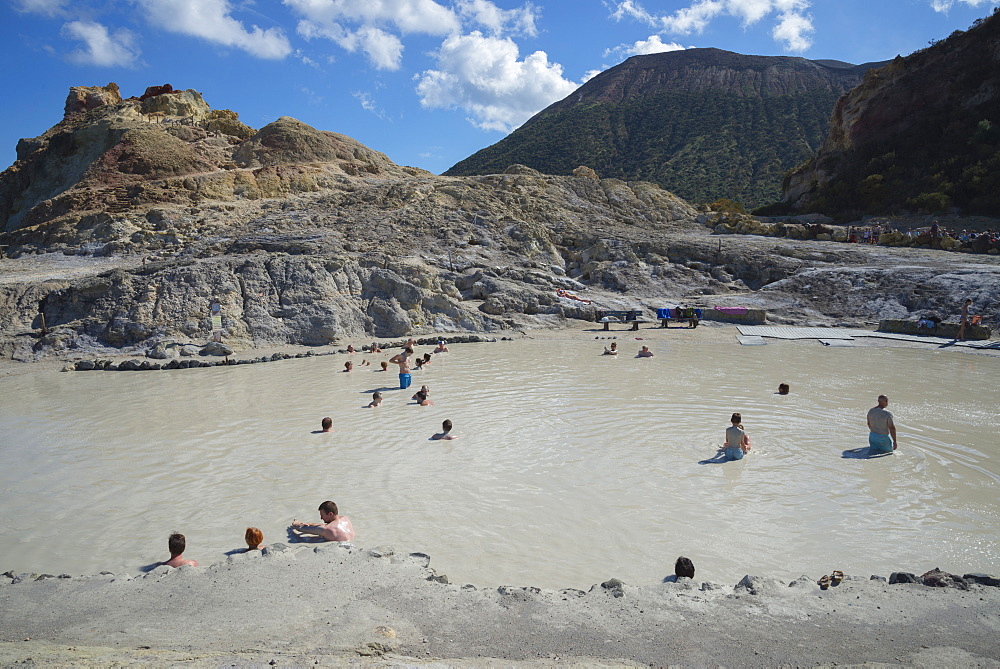Attività geotermica / Geothermal Activity
[IT]Il termine geotermico è usato per riferirsi al calore che proviene dall'interno della Terra. In tutto il mondo si può vedere la prova del funzionamento interno di terra in forma di attività geotermica - dove questo calore sale in superficie; il più eclatante dei quali sono vulcani. Lavica calda (roccia fusa) scoppia la sua strada fuori dalla terra e può fare per uno spettacolo sorprendente. Ma oltre a vulcani, lava e cenere, calore interno della terra si fa strada verso la superficie in altri modi unici attraverso geyser, fumarole, sorgenti termali e pozze di fango.
[EN]The term geothermal is used to refer to the heat that comes from earth's interior. All over the world you can see evidence of the inner workings of earth in the form of geothermal activity - where this heat rises to the surface; the most striking of which are volcanoes. Hot lava (molten rock) bursts it's way out of the ground and can make for a amazing sight. But besides volcanoes, lava, and ash, earth's internal heat makes its way to the surface in other unique ways through geysers, fumaroles, hot springs and mudpots.

[IT]Su questa posizione non solo trovare pozze di fango, ma anche sorgenti di acqua calda sotto la superficie dell'acqua nel mediterraneo. [EN] On this location you do not only find Mudpots, but also hot springs below the water surface in the mediteranean.
[IT]Il fango caldo è stato a lungo considerato un ottimo trattamento per i dolori reumatici e malattie della pelle, e se non ti dispiace che sente l'odore divertente per un paio di giorni, rotolandosi nel fango può essere divertente.
[EN]The warm mud has long been considered an excellent treatment for rheumatic pains and skin diseases, and if you don't mind smelling funny for a few days, rolling around in the mud can be fun.
[IT]Una volta che hai avuto il tempo di rilassarsi in acqua fangosa, un po 'di argilla morbida dal fondo della piscina e applicarlo al vostro corpo e del viso. Non lasciate che nessuno del fango ottenere nei tuoi occhi, come lo zolfo è acido e può danneggiare la cornea (tenere i capelli troppo senza fango). Attendere che la maschera di argilla ad asciugare, lavare in mare.
[EN]Once you have had time to relax in the muddy water, get some soft clay from the bottom of the pool and apply it to your body and face. Don't let any of the mud get in your eyes as the sulphur is acidic and can damage the cornea (keep your hair mud-free too). Wait for the clay mask to dry, wash it off in the sea.

Come funziona? / How does it work?
[IT]Pozze di fango si formano in alta temperatura aree geotermiche in cui l'acqua scarseggia. La poca acqua che è disponibile sale in superficie in un punto in cui il terreno è ricco di cenere vulcanica, argilla e altre polveri fini. Lo spessore del fango di solito cambia con variazioni stagionali della falda.
[EN]Mudpots form in high-temperature geothermal areas where water is in short supply. The little water that is available rises to the surface at a spot where the soil is rich in volcanic ash, clay and other fine particulates. The thickness of the mud usually changes along with seasonal changes in the water table.
[IT]La scoperta e successivo studio, di sorgenti idrotermali è abbastanza recente conquista scientifica. Nel 1949, i ricercatori del Mar Rosso hanno trovato l'acqua calda, altamente salina nelle profondità dell'oceano. Come acqua negli oceani profondi è generalmente compresa tra 2-4 gradi Celsius La presenza di questo domande acqua sollevata riscaldati e ricerche successive rivelato che era dovuta alla presenza di sorgenti idrotermali sul fondo dell'oceano. Da allora altre aperture sono state scoperte lungo molte delle dorsali medio-oceaniche, dove due placche tettoniche sono divergenti e nuova crosta si sta formando.
[EN]The discovery, and subsequent study, of hydrothermal vents is a fairly recent scientific achievement. In 1949, research workers in the Red Sea found hot, highly saline water in the deep ocean. As water in the deep oceans is generally between 2-4 degrees Celsius the presence of this heated water raised questions and subsequent investigations revealed that it was due to the presence of hydrothermal vents on the ocean floor. Since that time other vents have been discovered along several of the mid-ocean ridges where two tectonic plates are diverging and new crust is being formed.
[IT]Le sorgenti idrotermali sono a volte indicato come sorgenti subacquee calde, geyser, e / o fumarole, in quanto condividono alcune caratteristiche con tutti loro. L'acqua che sgorga camini idrotermali costituito prevalentemente da acqua di mare disegnata nel sistema vicino alla struttura vulcanica, con l'aggiunta di acqua fresca rilasciato da upwelling magma. Considerando che, in sistemi idrotermali terrestri, come geyser e fumarole, la maggior parte dell'acqua è fatta circolare acqua di falda che è penetrato giù nel sistema termico dalla superficie. L'acqua emesso da camini idrotermali può essere caldo come 474 gradi Celsius che in circostanze normali non sarebbe vapore (come con una fumarola). Tuttavia, a causa della elevata pressione del mare circostante alle profondità in cui bocche idrotermali trovano normalmente non bollire e si verifica in forma fluida. In alcuni casi, quando la profondità è grande abbastanza e la temperatura sufficientemente elevata, l'acqua si presenta come un fluido supercritico con proprietà fisiche tra quelle di un liquido e un gas.
[EN]Hydrothermal vents are sometimes referred to as underwater hot springs , geysers , and/or fumaroles, as they share some qualities with all of them. The water that pours out of hydrothermal vents consists mainly of sea water drawn into the system close to the volcanic structure, with the addition of some fresh water released by upwelling magma. Whereas, in land based hydrothermal systems, such as geysers and fumaroles, most of the water circulated is ground water that has seeped down into the thermal system from the surface. The water issued from hydrothermal vents can be as hot as 474 degrees Celsius which in normal circumstances would be steam (as with a fumarole). However, because of the high pressure of the surrounding ocean at the depths at which hydrothermal vents are normally found it does not boil and occurs in fluid form. In certain cases, where the depth is great enough and the temperature high enough, the water occurs as a supercritical fluid with physical properties between those of a liquid and a gas.
[IT]Alcune aperture di formare strutture camini come in cima. Questi formano i minerali disciolti nell'acqua sfiato surriscaldata precipitare quando incontra l'acqua di mare fredda circostante, aggiungendo alla dimensione della struttura come lo fanno. Questi tipi di bocchette come spesso conosciuto come i fumatori nero o bianco a seconda del minerale dominante nell'acqua (che causa il colore del camino). Nero fumatori sono generalmente il risultato di un elevato contenuto di solfuro che i fumatori bianchi sono costituiti da acqua ricca di minerali come bario, calcio e silicio.
[EN]Some vents form chimney-like structures atop. These form as minerals dissolved in the superheated vent water precipitate out when it meets the surrounding cold seawater, adding to the size of the structure as they do so. These type of vents as often known as black or white smokers depending on the dominant mineral in the water (which causes the color of the chimney). Black smokers are generally a result of a high sulfide content whereas white smokers are formed by water rich in minerals such as barium, calcium and silicon.
Il Sito / The Site
[IT]A questa posizione si può prendere un bagno di fango, ma l'ammissione deve essere pagato. Se preferite potete als camminare intorno al bagno di fango e inserire teh mare senza costi e sperimentare il caldo (attenzione in alcuni luoghi HOT) temperature dell'acqua
[EN]At this location you can take a mud bath, but admission has to be paid. If you prefer you can als walk around the mud bath and enter teh sea without costs and experience the warm (watch out at some places HOT) water temperatures.
[IT]Per registrare questa cache terra risposta le seguenti domande:
1. Quanto è grande il diametro della piscina di fango in metri circa?
2. In che direzione va la piscina quasi incontrare de mare?
3. Che cosa si sente odore? E perché odore in questo modo?
4. Opzionale: Aggiungere una foto di te stesso in corrispondenza o in  la piscina di fango
la piscina di fango
[EN]To log this earth cache Awnser the following Questions:
1. How big is the diameter of the mud pool in meters approximately?
2. In what direction does the pool nearly meet de sea?
3. What do you smell? And why does it smell this way?
4. Optional: Add a picture of yourself at or in  the mudpot
the mudpot
Dunaghiri Earthcache Stats

| I am a proud |
 |
| I am a proud |
 |
| I am a proud |
 |